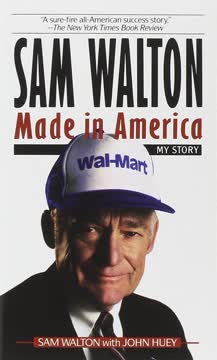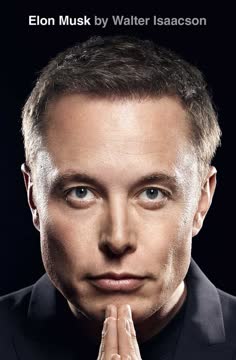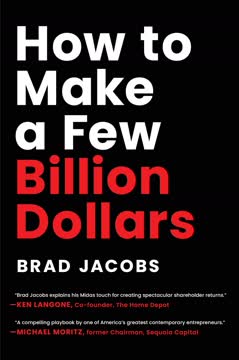Key Takeaways
1. Early Entrepreneurial Drive and the Direct Model
My parents had a saying for when my brothers and I went out to play street ball with our friends: “Play nice but win.”
Curiosity fueled ambition. From a young age, Michael Dell was driven by intense curiosity, particularly about how things worked, especially electronics. This led to early entrepreneurial ventures, like selling stamps and newspaper subscriptions, demonstrating a knack for identifying inefficiencies and arbitrage opportunities. This foundation in direct sales and cost efficiency became the bedrock of his future company.
Identifying market gaps. Observing the high markups and lack of service in early computer retail stores, Dell saw an opportunity to sell customized PCs directly to customers. This build-to-order model, initially born out of necessity due to limited capital, offered significant advantages:
- Lower costs by cutting out middlemen.
- Reduced inventory risk by building only what was ordered.
- Direct customer feedback for continuous improvement.
- Faster delivery of the latest technology.
A competitive philosophy. The family motto, "Play nice but win," instilled a core belief in competing fiercely while maintaining ethical standards. This blend of ambition and integrity guided Dell's approach to business from his dorm room beginnings, setting the tone for the company's culture and competitive strategy against larger, established players like IBM and Compaq.
2. Building a Scrappy, Fast-Growing Company
We were a ragtag bunch of computer buccaneers, and the sheer level of activity could get daunting sometimes.
Rapid, chaotic growth. Starting with just $1,000, Dell's PC upgrade and resale business quickly scaled, moving from an apartment to small offices. The direct model fueled explosive growth, attracting a diverse group of early employees who were passionate and adaptable. This period was marked by improvisation and learning on the fly.
Early team dynamics. The initial team was small and multi-talented, with everyone wearing multiple hats. The culture was scrappy, lively, and collaborative, driven by a shared excitement for the burgeoning PC revolution. Key early hires included:
- Terry Hostetler (software expertise, office management)
- Jay Bell (engineering for 286 prototype)
- Kaye Banda (assistant, surrogate mother figure)
- A small crew of fellow UT students for installations.
Outgrowing infrastructure. The rapid expansion quickly strained existing systems, from order entry (clotheslines!) to bookkeeping and physical space. This constant need to scale infrastructure and processes while maintaining growth became a defining challenge of the early years, requiring continuous adaptation and investment.
3. Navigating Early Crises and Learning Resilience
Every failure and setback made me and our company stronger and more resilient.
Facing existential threats. The company's early journey was punctuated by several near-death experiences that tested its resilience. These crises, though terrifying at the time, forced critical learning and adaptation:
- Financial strain due to rapid growth and limited capital.
- Regulatory challenges (FCC cease-and-desist over emissions).
- Legal battles (IBM patent infringement claims).
- Quality control issues with early products.
Learning from setbacks. Each crisis provided invaluable lessons, shaping operational discipline and strategic thinking. The FCC issue, for instance, highlighted the need for rigorous engineering and compliance, while the IBM patent issue underscored the importance of intellectual property and legal strategy. These experiences built a muscle for problem-solving under pressure.
Persistence as a core trait. Despite the daunting nature of these challenges, a refusal to give up became ingrained in the company's DNA. This persistence, combined with a willingness to learn from mistakes and adapt quickly, was crucial for surviving the volatile early years and laying the groundwork for future success.
4. The Power of Strategic Partnerships and Mentorship
I needed help from someone who knew the kinds of things that I didn’t know.
Seeking experienced guidance. Recognizing the limits of his own experience as a young founder, Dell actively sought out seasoned executives and mentors. These relationships provided crucial expertise in areas like finance, operations, and corporate structure that were essential for scaling the business beyond its start-up phase.
Key mentors and partners:
- Lee Walker: Provided financial discipline, access to capital, and operational structure, transforming the company's financial footing.
- Mort Topfer: Brought deep experience in managing large, international technology divisions (from Motorola), helping professionalize the organization for global expansion.
- Kevin Rollins: Offered brilliant strategic insights and helped redefine the company's culture and future direction.
- Joe Tucci: CEO of EMC, became a key partner in strategic alliances and eventually the massive merger.
Complementary skills. The most effective partnerships, like those with Walker, Topfer, and Rollins, were built on complementary skills and mutual trust. This allowed for a division of labor where Dell could focus on product vision and growth while partners brought expertise in areas needed for stability and scale.
5. Embracing Direct Sales and E-commerce at Scale
The way I saw it, online purchasing and our direct sales model were a perfect marriage.
Extending the direct model. The core advantage of selling directly to customers was amplified by the advent of the internet. Dell was an early adopter of e-commerce, recognizing its potential to enhance efficiency and customer interaction. The website became a powerful tool for sales, configuration, and support.
Benefits of online direct sales:
- Customers could configure and price their ideal system instantly.
- Streamlined order processing and reduced sales costs.
- Real-time access to technical information and support.
- Enhanced supply chain efficiency through direct order flow.
Rapid e-commerce growth. Dell's online sales grew exponentially, quickly reaching $1 million a day and becoming a significant part of the business. This early success in e-commerce solidified the direct model as a sustainable competitive advantage, allowing the company to bypass traditional retail channels and connect directly with a global customer base.
6. Cultivating a Strong Culture and Core Values
A company without soul, he knew, was a company that could fray and break apart in any number of ways.
Defining early values. From the beginning, Dell articulated core values focused on quality, customer service, respect for people, continuous learning, and winning. These principles guided the company's interactions internally and externally, fostering a sense of purpose beyond just financial success.
Challenges to culture. Rapid growth and market pressures, particularly during the dot-com boom, strained the initial culture. An overemphasis on financial performance and stock price led to issues like internal competition and a focus on individual wealth ("Dellionaires"), sometimes overshadowing teamwork and customer focus. Layoffs during the bust further tested employee trust.
Reaffirming and evolving values. In response to these challenges and the post-9/11 period of reflection, Dell and Kevin Rollins led an effort to redefine and deepen the company's values, resulting in "The Soul of Dell." This initiative aimed to re-engage employees by emphasizing:
- Creating loyal customers through superior experience.
- Teamwork and employee growth.
- Direct communication and non-hierarchical structures.
- Global corporate citizenship.
- A passion for winning and operational excellence.
7. Recognizing the Need for Transformation Beyond PCs
We’re really not a PC company anymore.
Shifting market dynamics. While PCs were the foundation, Dell recognized early on that the technology landscape was evolving rapidly. The value was shifting from hardware to software, services, and data center solutions. Relying solely on the low-margin PC business was not a sustainable long-term strategy.
Investing in new areas. Dell began strategically acquiring companies and building capabilities in adjacent markets to become an end-to-end IT solutions provider. Key areas of focus included:
- Servers (re-entering the market with PowerEdge).
- Storage (acquiring EqualLogic).
- Software and Security (acquiring Quest, SonicWALL, Secureworks, etc.).
- Services (building a large services division).
Public market skepticism. Despite these efforts, the public market and many analysts continued to view Dell primarily as a PC company. This narrow perception led to the company being undervalued, as investors failed to fully appreciate the investments and progress being made in higher-margin, growth areas. This disconnect highlighted the limitations of being a publicly traded company focused on short-term results.
8. The Strategic Decision to Go Private
Going private would open up the possibility of dramatically accelerating the growth of the company and allow us to have a far greater impact in the world.
Undervaluation as opportunity. Seeing the company's stock price languish due to public market focus on the declining PC business, Dell recognized an opportunity. Taking the company private would free it from the pressures of quarterly earnings reports and allow for necessary long-term investments and strategic shifts without immediate Wall Street scrutiny.
Exploring the possibility. The idea of going private had been considered before, but it gained momentum when major shareholders and private equity firms like Southeastern Asset Management and Silver Lake Partners independently suggested it. Dell engaged with these parties while navigating complex corporate governance requirements, including forming a special committee of independent directors.
The need for transformation capital. The strategic shift towards enterprise software and services required significant investment in R&D, sales capacity, and acquisitions. These investments would negatively impact short-term profitability, which public markets typically punish. Going private provided the necessary flexibility and capital structure to pursue this transformation aggressively.
9. Battling Activist Investors and Defending the Vision
I was disgusted by Carl’s complete lack of moral fiber.
Opposition emerges. The plan to go private faced significant opposition, most notably from activist investor Carl Icahn and major shareholder Southeastern Asset Management. They argued the offer price undervalued the company and proposed alternative strategies, including keeping Dell public or a leveraged recapitalization.
Icahn's tactics. Carl Icahn employed aggressive, public tactics, including media campaigns, open letters to shareholders, and legal challenges. His goal was often to pressure the buyers to raise the offer price, benefiting his own stake, rather than necessarily taking control or implementing a long-term strategy for the company. His methods were often characterized by:
- Gross inaccuracies and misrepresentations.
- Personal attacks on Dell and the board.
- Creating chaos and uncertainty.
Defending the deal. Dell and the special committee defended the buyout as the best option for shareholders, offering a significant premium over the unaffected stock price and allowing the company to pursue its transformation strategy free from public market constraints. Legal victories and proxy advisory firm support ultimately helped sway the vote.
10. Unleashing Potential as a Private Company
Suddenly the shackles really were broken.
Freedom to invest. Going private immediately removed the pressure of meeting quarterly earnings expectations, allowing Dell to make significant, long-term investments in strategic areas. This included dramatically increasing spending on R&D and sales capacity, particularly in underserved markets like small and medium-sized businesses.
Increased agility and speed. As a private entity, decision-making became faster and more agile. The company could implement strategic initiatives immediately, rather than debating their short-term impact on public financials. This newfound speed was critical in the rapidly changing tech landscape.
Employee re-engagement. The privatization process, despite the preceding battle, proved highly energizing for employees. Freed from the public market's focus on stock price, the team could refocus on innovation, customer satisfaction, and long-term growth. Employee morale and engagement metrics saw significant improvement.
11. The Bold Acquisition of EMC and VMware
The biggest, boldest, brightest prize, Egon and I agreed, would be EMC/VMware.
Identifying a transformative opportunity. Building on the success of the private period, Dell sought a major acquisition to accelerate its transformation into an IT infrastructure powerhouse. EMC, with its leading storage business and majority ownership of virtualization leader VMware, represented a unique opportunity to combine complementary strengths and achieve unprecedented scale.
Navigating complexity. Acquiring EMC, a public company significantly larger than Dell, presented immense financial and structural challenges. Key hurdles included:
- Raising over $60 billion in financing.
- Integrating three distinct companies (Dell, EMC, VMware) with different cultures.
- Addressing the value and future of VMware's public tracking stock.
- Securing regulatory approvals worldwide.
Innovative financing. The deal required creative financial engineering, including the use of a VMware tracking stock to provide value to EMC shareholders and reduce the amount of new debt needed. The support of major financial institutions, particularly JPMorgan Chase led by Jamie Dimon after the passing of Jimmy Lee, was critical in securing the necessary funding.
12. Integrating Cultures and Leading a Global Powerhouse
We’re in this together.
Melding distinct cultures. Integrating two massive organizations, each with its own history, culture, and operational norms, was a significant undertaking. Dell focused on creating a unified culture based on shared values, emphasizing collaboration and mutual respect among employees from Dell, EMC, and VMware.
Strategic talent integration. The merger created a deep pool of talent, requiring careful decisions about leadership roles and team structures. The focus was on retaining the best people from across all organizations and building a leadership team capable of executing the combined company's ambitious strategy.
Emerging as an IT leader. The combination created Dell Technologies, a privately controlled global leader in IT infrastructure. By integrating servers, storage, virtualization, software, and services, the company was uniquely positioned to help customers navigate digital transformation and the explosion of data, achieving significant market share gains in key sectors.
Last updated:
Review Summary
Play Nice But Win receives mixed reviews. Many praise Dell's entrepreneurial journey and business insights, particularly regarding Dell's privatization and EMC merger. Readers appreciate the blend of personal anecdotes and corporate strategy. However, some criticize the lack of introspection and self-reflection, feeling the book comes across as self-congratulatory. The writing style, alternating between past and present, divides opinions. Overall, the book is seen as valuable for those interested in business and technology, though some find it less engaging than other CEO memoirs.
Similar Books










Download PDF
Download EPUB
.epub digital book format is ideal for reading ebooks on phones, tablets, and e-readers.




